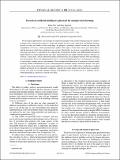Toward an artificial intelligence physicist for unsupervised learning
Author(s)
Wu, Tailin; Tegmark, Max
DownloadPublished version (1.925Mb)
Publisher Policy
Publisher Policy
Article is made available in accordance with the publisher's policy and may be subject to US copyright law. Please refer to the publisher's site for terms of use.
Terms of use
Metadata
Show full item recordAbstract
© 2019 American Physical Society. We investigate opportunities and challenges for improving unsupervised machine learning using four common strategies with a long history in physics: divide and conquer, Occam's razor, unification, and lifelong learning. Instead of using one model to learn everything, we propose a paradigm centered around the learning and manipulation of theories, which parsimoniously predict both aspects of the future (from past observations) and the domain in which these predictions are accurate. Specifically, we propose a generalized mean loss to encourage each theory to specialize in its comparatively advantageous domain, and a differentiable description length objective to downweight bad data and "snap" learned theories into simple symbolic formulas. Theories are stored in a "theory hub," which continuously unifies learned theories and can propose theories when encountering new environments. We test our implementation, the toy "artificial intelligence physicist" learning agent, on a suite of increasingly complex physics environments. From unsupervised observation of trajectories through worlds involving random combinations of gravity, electromagnetism, harmonic motion, and elastic bounces, our agent typically learns faster and produces mean-squared prediction errors about a billion times smaller than a standard feedforward neural net of comparable complexity, typically recovering integer and rational theory parameters exactly. Our agent successfully identifies domains with different laws of motion also for a nonlinear chaotic double pendulum in a piecewise constant force field.
Date issued
2019Department
Massachusetts Institute of Technology. Department of Physics; Center for Brains, Minds, and MachinesJournal
Physical Review E
Publisher
American Physical Society (APS)